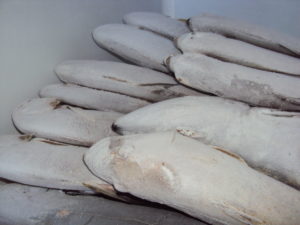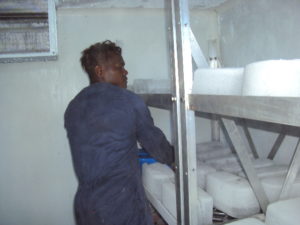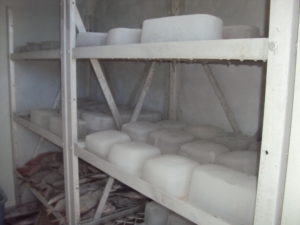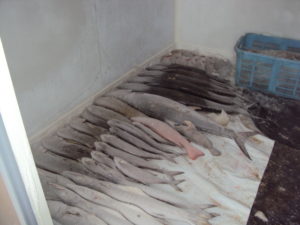Pelena Freezer Room and Ice Making
The Pelena Freezer Room provides:
- ice production
- ice storage
- food storage
- storage time to wait for shipping
Background
Over more than 20 years, Pelena personnel visited many ice-making and ‘fisheries’ projects throughout Melanesia. Without exception, all were operating at less than expected levels. Pelena investigated and found a number of design issues associated with all of these projects, namely:
- They constantly needed specialist (outside) refrigeration mechanics and equipment. The Pelena Freezer Room does not. In the unlikely event repairs are needed, the compact refrigeration unit can simply be removed from the freezer room and taken to town for repairs.
- They had a large variety of equipment; ice-makers, ice crushers, cool rooms, freezer rooms etc, all subject to breakdowns and requiring specialist outside assistance for maintenance. The Pelena Freezer Room is a single multi-purpose room which can be used to make ice, store ice and food. Simple yet effective. Simple and reliable.
- Ice-makers were expensive and only produced fresh-water ice. This melts at zero degrees Celsius meaning the coldest produce that can be stored during transport is typically only zero degrees Celsius resulting in cold, but thawed, produce needing rapid selling at the markets. The Pelena Freezer Room can make brine ice resulting in produce arriving at market frozen solid at typically -15 degrees Celsius (minus 15 degrees Celsius). This extends the effective beneficial range of the freezer room well beyond the freezer room itself, benefitting other communities.
What is brine ice?
Brine ice is made by freezing a solution (mixture) of fresh water and common salt. The concentration (ratio) is important. Sea water has insufficient salt to drop the freezing point of water very much below zero degrees Celsius.
Why is brine ice important?
This is best described as an example: Fish and meat freezes (or melts) at about -1.5 degrees Celsius. Fresh water ice freezes (or melts) at 0 degrees Celsius. If you have some frozen fish and some frozen fresh water ice in a freezer at -25 degrees Celsius, and you remove the frozen product and put them in an ‘esky’ (also known as coolers, portable ice coolers, ice box, chilly bins), then the temperature of both the ice and the meat will start to rise. However, because the melting point of the fish is lower than the melting point of the fresh water ice, the frozen fish will begin to melt first. When the produce arrives at market, the melted (soft) fish will be floating in a slurry of ice. However, with the Pelena brine ice, the freezing (and melting) point of the brine ice is about -15 degrees Celsius. In this case, if frozen Pelena brine ice and the frozen fish are placed in an esky, then the brine melts first, keeping the frozen fish ‘rock-hard’ frozen! This allows the frozen fish or other meat to arrive at market frozen, gaining a better price and resulting in better food hygiene and less waste.
In some situations, the brine mixture can be placed in sealed plastic bottles for re-use, but more commonly blocks are made using low-cost bulk salt.
A Pelena Freezer Room was installed at Masupa, see Full Project Details here.



